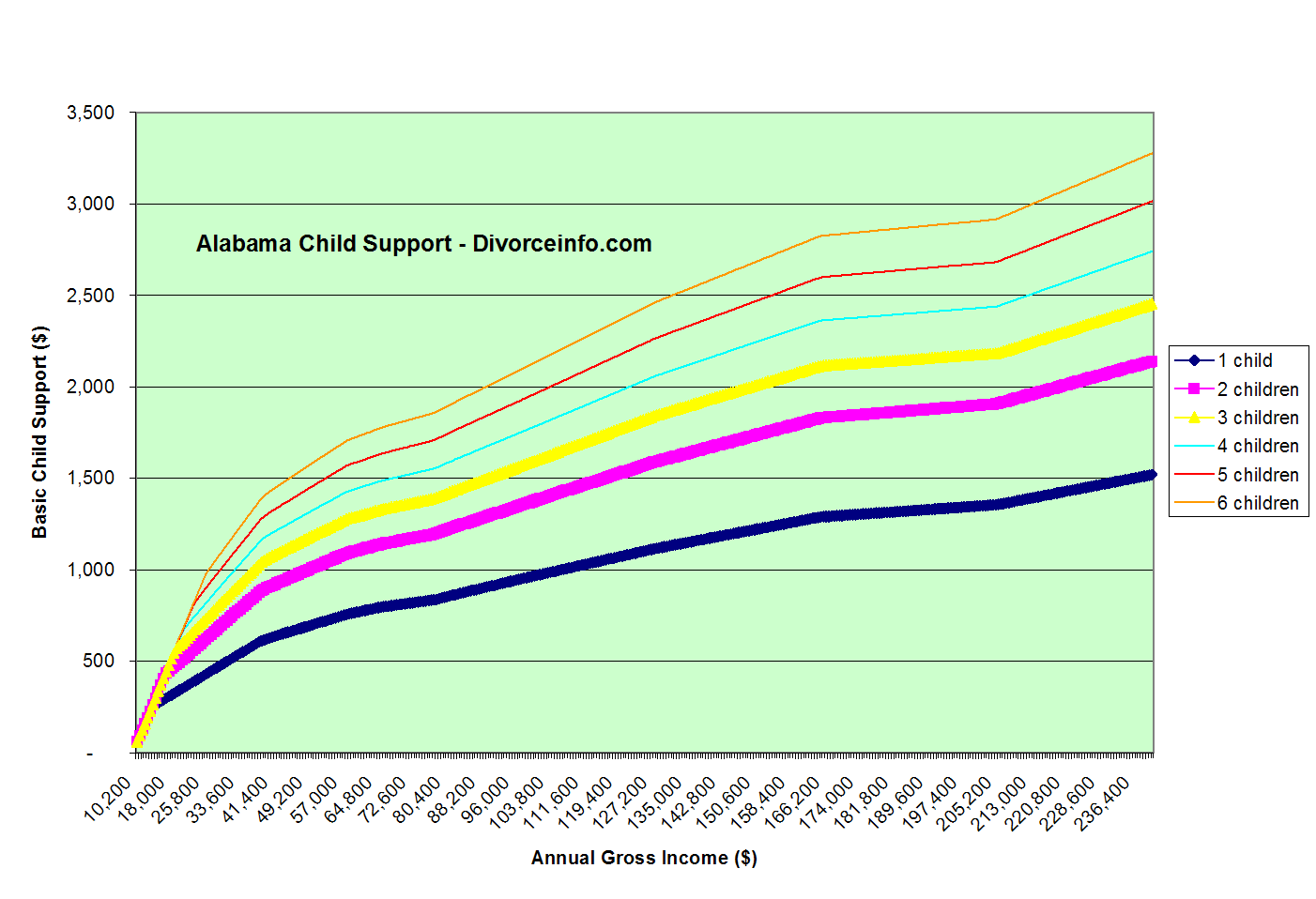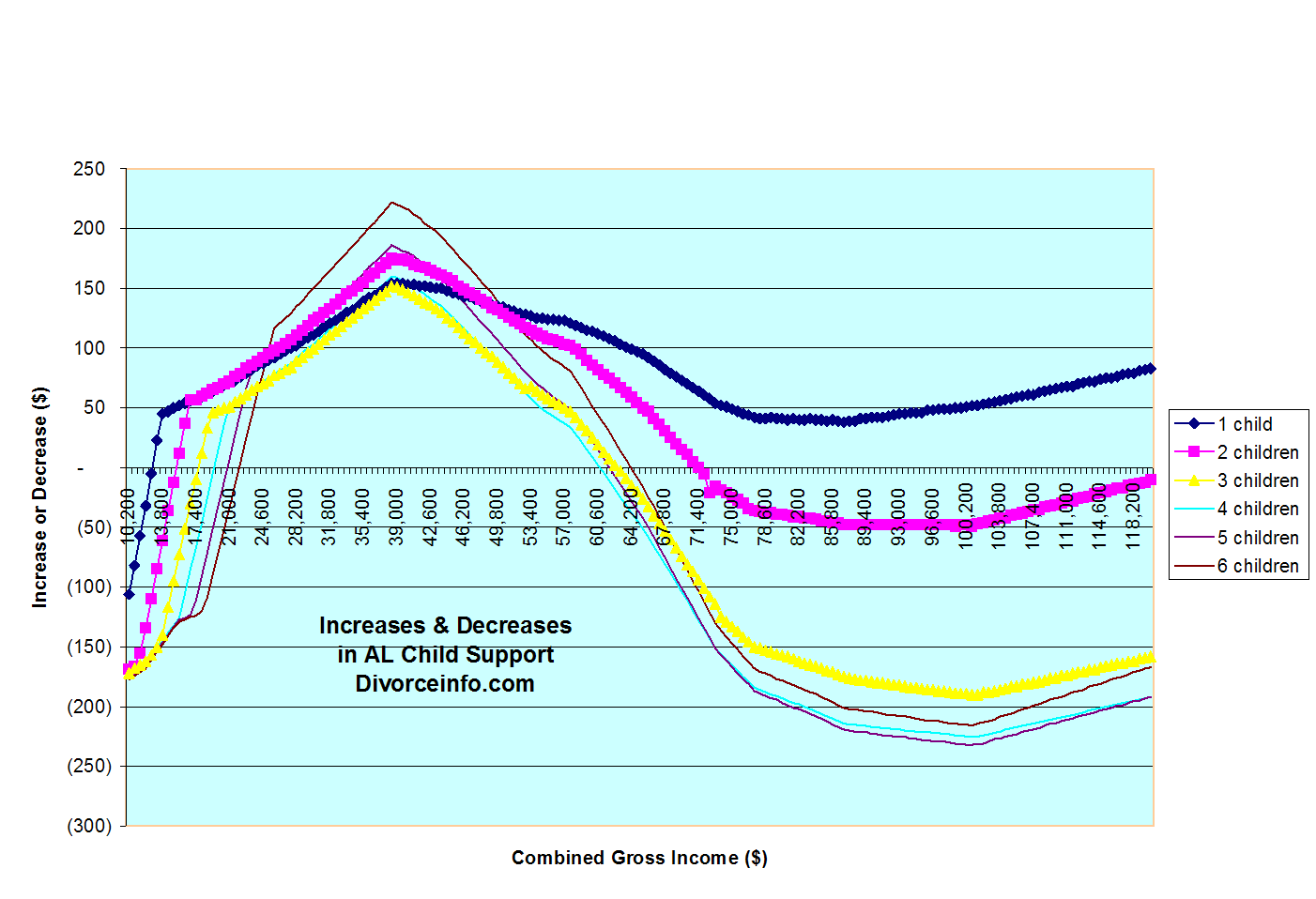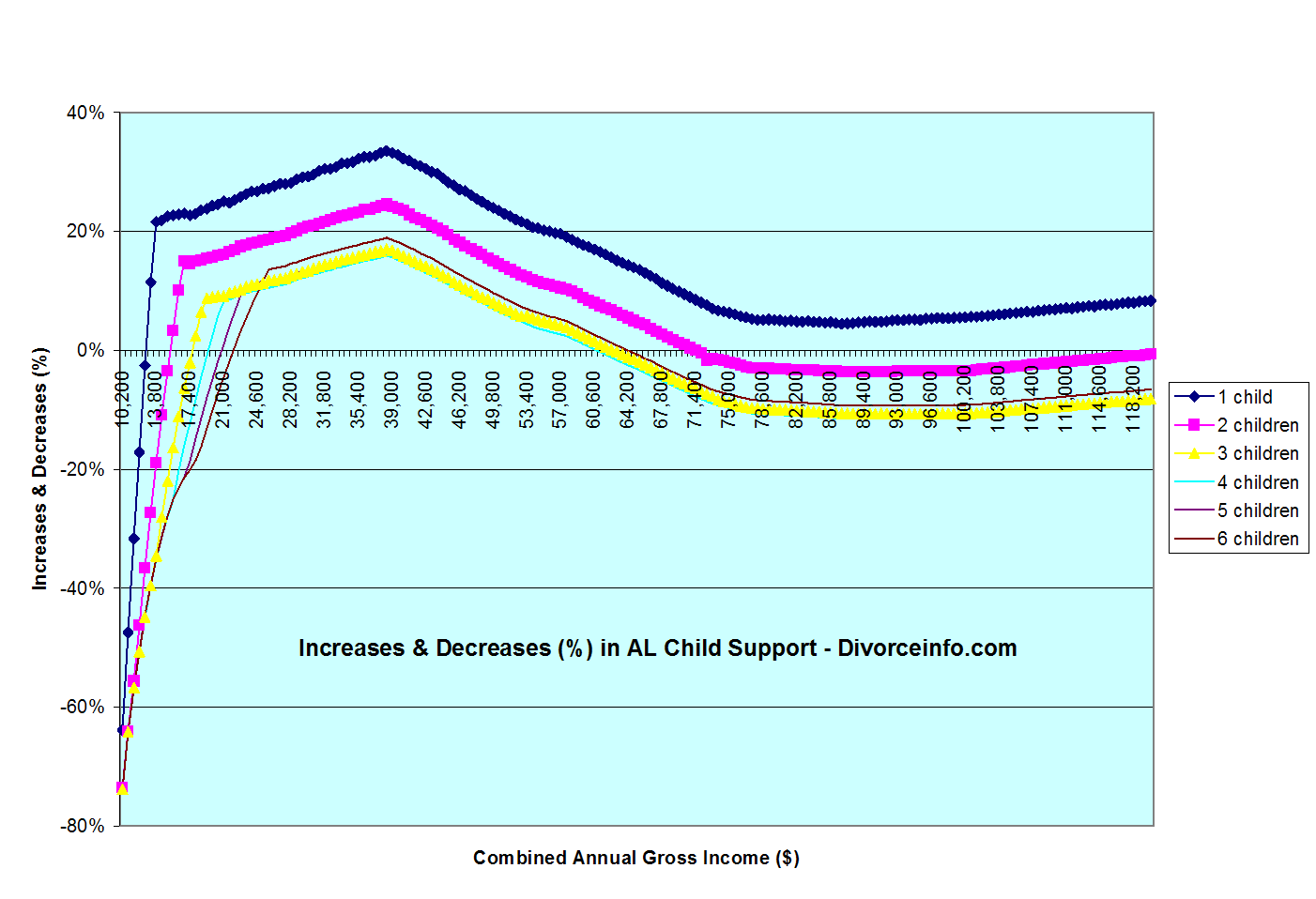New child support guidelines took effect in Alabama on January 1, 2009. They apply by their terms to “all new actions filed or proceedings instituted on or after January 1, 2009.” This is widely taken to mean that these new guidelines do not apply to cases for which the original complaint was filed before January 1, 2009. This is, as my Daddy would have said, “kinda right.”
The new guidelines are different from those in effect for prior years in several ways: First, they cover a broader range of incomes. The old guidelines extended to annual incomes as low as $6,600 and as high as $120,000. Below and above that range, child support was in the discretion of the court. The new guidelines extend to annual incomes as low as zero and as high as $240,000. Above that range, as before, child support is in the court’s discretion.
Here is a graph showing the basic child support amount for different family sizes. As I will throughout, I use a bolder line for the more common family sizes of 1, 2, and 3 children and a thinner line for the less common family sizes of 4, 5, and 6 children. I have absolutely no explanation for the “plateauing” effect for incomes of $160,000-$200,000. I can only tell you that it applies to all family sizes. It also appears that the basic child support amounts increase in an unremarkable fashion once they exceed the $120,000 threshold from the pre-2009 guidelines.

Next, let’s look at the difference between the guidelines. For obvious reasons, there is and can be no comparison for incomes above $120,000, so this next chart stops at $120,000. Ah, now it gets interesting. This chart shows that in the range of incomes that matters to most Alabamians, from $20,000 to $60,000 (Alabama’s median household income is $40,500), the new guidelines are more generous to custodial parents and less generous to non-custodial parents regardless of family size. It also shows that the new guidelines call for more child support for all families involving only one child, regardless of income.

Because I always like to understand percentage changes as well as changes in raw numbers, I’ve included a chart below showing the changes in basic child support expressed in percentage terms rather than in dollar terms. I’m frankly not sure it adds much to one’s understanding other than to answer the question of people like me who like to see the percentage change.

Aside from the numbers, there are some other changes worth noting. For example, the 2009 guidelines introduce a requirement that a person wishing to change child support must plead and prove that a substantial and continuing material change in circumstances has occurred since the last order of child support. Pre-2009, the clear test was whether child support would change by 10% or more. Now the court has discretion to modify for less than a 10% change and to decline to modify even when the child support would change by more than 10%.
The new guidelines also build in a more specific plan for review of the guidelines once every four years, presumably designed to avoid the recent lengthy delay in reviewing them.
In comparing the new guidelines with the former gudelines.. I believe I read where the former guidelines had not be modified in 15 years. If in fact that is true, randomly selecting monthly incomes former: $8100/month = $902 per month for one child New: $8100/month =$951 per month for one child. former: $9150/month =$954 per month for one child New: $9150/month = $1020. So, if your monthly income is $8100 the increase to you is $49 per month or $588 per year and this hasn’t been increased in 15 years? So,that is equal to $39 a year over the past 15 years. The $9150 monthly income increases $66 per month or $52.80 per year for each of the past 15 years. Also, it appears that one child is about 7-11 % of the incomes listed. I have seen national levels at 14-15%. There is no adjustment for age.Teenagers are more expensive than seven year olds. With the price of food, gas, clothing, school fees, etc, these “increases” are ridiculous. I see the list of all the collaborative organizations and data that went into this modification but the question I have is are any of these people parents? do any of these folks grocery shop? buy clothes for their children?– Are any of these people who make these decisions single custodial parents?
Thanks for listening.
Denyse Newbery
I honestly don’t know how long it’s been since the guidelines were revised, but you’re right that it’s been a long time. I haven’t tried to check the numbers you’re quoting, but assuming they’re correct, let’s look at what they mean.
AT A GIVEN LEVEL OF INCOME (capitalized because that’s an important qualifier), the basic child support has increased only slightly. So let’s look at the second chart, at a gross income of $39,000. There’s an increase of $150 per month. Does that mean that the average custodial parent has seen an increase of $150 per month in 15 years? No, because during that 15 years, most noncustodial (and custodial) parents have experienced an increase in their gross incomes. What you’re seeing is an increase at a given level of income, not an average increase for parents. I don’t know the figures, but I’m confident the average basic child support amount has increased much more than that, simply as a product of inflation.
You’re quite right that expenses rise for teenagers over those for very young children. Because the guidelines are based on AVERAGE expenses for all ages, one can assume they over-compensate the custodial parents of infants and under-compensate the parents of teenagers. CPs of infants rarely complain about it; CPs of teenagers often do. If you would like to address it, I invite you to take it up with the legislature and the Supreme Court, but when you do, know that you would be asking them to move Alabama away from the vast majority of states (virtually all of which fail to account for the change in expenses as children age).
I am acquainted with nearly all the members of the Supreme Court Advisory Panel that developed these guidelines and friends with several of them. They have worked on this for years, providing many hours and attending many meetings without charging you or me for their time. I can answer your questions about their experience as parents and consumers this way: Yes. Yes. Yes. I’m not sure, but I think so.
Under the old guidelines “Rule 32” took into account some other issues regarding the changing of child support. Courts were not obligated to apply Rule 32, but do the courts/judges still have this discretion?
Rule 32 enumerates five non-exclusive reasons courts may, but need not, deviate from the guidelines:
– Shared physical custody or visitation rights providing for periods of physical custody or care of children by the obligor parent substantially in excess of those customarily approved or ordered by the court.
– Expenses of college education incurred prior to a child’s reaching the age of majority.
– Assets of, or unearned income received by or on behalf of, a child or children.
– Such other facts or circumstances that the court finds contribute to the best interest of the child or children for whom support is being determined.
I am really confused. Probably moreso out of desperation than any thing else. My husband makes 100,000 year. I am disabled and receive about 8,000 a year in SSD. We have five kids and I finally scraped up enough money to hire an attorney but it appears that the child support range has changed to be more in his favor than the kids if I am looking at this correctly. Has the support calculator been updated to represent the new guidelines?
Yes, the calculator at https://divorceinfo.com/alchildsupport.htm applies the guidelines that became effective January 1, 2009.